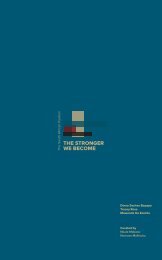TSWB Catalogue
You also want an ePaper? Increase the reach of your titles
YUMPU automatically turns print PDFs into web optimized ePapers that Google loves.
The South African Pavilion<br />
THE STRONGER<br />
WE BECOME<br />
ARTS AND CULTURE MINISTER’S FOREWORD<br />
Mr Nathi Mthethwa<br />
South Africa’s glorious and colourful history with<br />
the Venice Art Biennale has once again brought<br />
the country’s rich visual art heritage to the fore at<br />
the 58th Venice Art Biennale organized by La Biennale di<br />
Venezia and presided by Paolo Baratta.<br />
Hosted every other year, in Arsenale, Venice, the<br />
exhibition which opened on 11 May continues until 24<br />
November 2019.<br />
The International Art Exhibition sometimes referred - to as<br />
the “Art Olympics” has become an important part of our<br />
national cultural calendar, along with that of the world.<br />
This is why our presence as a youthful democratic<br />
country and our showing at the exhibition through the<br />
South African Pavilion is central to our national strategic<br />
vision of nurturing and growing the visual arts industry.<br />
As the Department of Arts and Culture, we see visual arts<br />
as one of the key drivers of economic growth, through<br />
the promotion of our artists as well as in building<br />
international relations and stimulating cultural tourism.<br />
South Africa is indeed a country of talented visual artists<br />
whose artistic endeavors have always been world class.<br />
Even during the dark days of apartheid our artists have<br />
fashioned themselves as world leaders, if not<br />
world-beaters.<br />
It was precisely in 1950 that South Africa made its debut at the 25th Venice Biennale, exhibiting in the foreign halls and<br />
public gardens of the Biennale. Some of the first artists to represent the country in the 50s and 60s include Stern and<br />
Walter Battiss, Alexis Preller, Maud Sumner, Sydney Kumalo and Maurice van Essche. However, between the 70s right<br />
through to the early 90s, and due to international sanctions against apartheid policies, our artists could not continue to<br />
showcase in Venice. The country re-emerged in 1993 and 1995, just a year before and after the first general elections in<br />
1994.<br />
South Africa returned to the Biennale from 2011 led by the Department of Arts and Culture, which undertook the<br />
responsibility and ownership of the country’s participation at the Bienalle. The 2011 exhibition featured works of artists<br />
such as Mary Sibande, Siemon Allen and Lyndi Sales at the Torre di Porta Nuova presented by Gallery MOMO.<br />
This was followed by the works curated by Brenton Maart who showcased the splendid works of artists, Johannes<br />
Phokela, Wim Botha, and the Centre for Historical Re-enactments, David Koloane, Live Art Collective, George Mahashe,<br />
Santu Mofokeng, Sam Nhlengethwa, Cameron Platter, Andrew Putter, Penny Siopis, Sue Williamson, under the title:<br />
Imaginary Fact: Contemporary South African Art and the Archive.<br />
In 2015, the South Africa was represented by world renowned group of artists among them; Jeremy Wafer, Willem<br />
Boshoff, Brett Murray, Mohau Modisakeng, Robin Rhode, Nandipha Mntambo, Warrick Sony, Diane Victor, Gerald<br />
Machona, Serge Alain Nitegeka, Jo Ratctliffe, Mark Lewis, Angus Gibson, Haroon Gunn-Salie, and the presentation of the<br />
iconic Rivonia Treason Trial 1964 sound recordings. The showcase titled: What Remains is Tomorrow was designed by<br />
curators Jeremy Rose, and Christopher Till and explored iterations of power, freedom and civil liberties.<br />
The South African Pavilion<br />
THE STRONGER<br />
WE BECOME<br />
arts & culture<br />
Department:<br />
Arts and Culture<br />
REPUBLIC OF SOUTH AFRICA<br />
03




